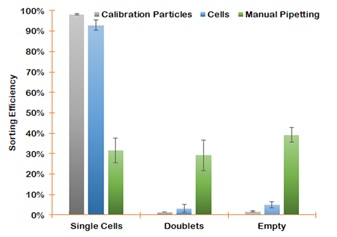Analysis of single cell sorting efficiency
Single cell sorting efficiency of Namocell
introduction
Manual limited dilution is one of the most classical methods of separating single cells when cultured in monoclonal cells. Single cells are isolated in this manner, and the number of cells that fall into each well is consistent with the Poisson distribution. The efficiency of single cell separation by single cell sorting instrument is significantly better than manual limiting dilution method, both in sorting ability and repeatability. The standard method for determining the efficiency of sorting a device is to use a fluorescent calibration microsphere to sort the test.
experimental method
The Namocell single cell separator was used to sort fluorescent calibration microspheres (Spherotech) and CHO-S cells stained with Calcein AM (Thermo Fisher Scientific) by detecting the FITC fluorescence signal. The isolated cells can be stained with Calcein AM to distinguish between debris, dead cells and living cells, and then individual living cells can be isolated according to the procedure recommended by Namocell. In order to remove cell agglomeration, the cells can be filtered with a cell sieve of about 40 μm after staining, and try to ensure that the samples are single cells at the time of loading. As a control, we used a cell density of 1 cell/well for manual limiting dilution plating. Then, the number of cells (or microspheres) per well was observed under a bright field with a microscope. The same experiment lasted for 7 days, a set of comparative experiments were performed each day, and the average was taken. The sorting efficiency of the instrument was measured by counting the number of single cells, two cells, and empty wells in the well plate.
Experimental results
A comparison of the microspheres and cells separated by the Namocell single cell separator and manual plating was shown in the legend. Fluorescent microspheres sorted by the Namocell single cell separator maintained good agreement - 97% for single cells, 1% for two cells, and 2% for blanks. Cell samples sorted by Namocell single cell separator - 93% single cells, 2% two cells, 5% blank. According to the sample data, the sorting efficiency obtained by the manual limiting dilution method was 31% for single cells, 35% for two cells, and 34% for blanks.
In the state where the degree of dispersion of the cell sample is relatively good, the highest single cell ratio of the machine separation is 97%. For the manual limited dilution method, the results of the experiment were inconsistent (as can be seen by the standard deviation). In summary, the sorting efficiency and consistency of the Namocell single cell separator is much better than the manual limited dilution method.

Legend: Comparison of average sorting efficiency and manual separation of machine-separated microspheres and cells.
PVC
Coated Wiggle Wire will help to ensure that your greenhouse can weather the
elements and last for years. Unlike other attachment methods, Wiggle Wire will
hold up to high winds and harsh environments. Protect your investments by using
the right products. The PVC Coated Wiggle Wire prevents tears for a fast
frustration free installation. This Spring Wire is the superior choice of
Wiggle Wire compared to the non-coated version. The PVC coating prevents tears
and is easier to handle. It is reusable and can easily be installed and removed
by "wiggling" it in and out of the Lock Channel. For use with poly
greenhouse film, curtains, shade cloth and other greenhouse coverings.
Plastic Coated Steel Wire,Plastic Coated Wire,Pvc Coated Wire Mesh,Plastic Coated Wire Mesh
JIANGSU SKYPLAN GREENHOUSE TECHNOLOGY CO.,LTD , https://www.greenhousehydroponic.com